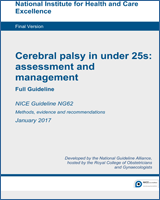NCBI Bookshelf. A service of the National Library of Medicine, National Institutes of Health.
National Guideline Alliance (UK). Cerebral palsy in under 25s: assessment and management. London: National Institute for Health and Care Excellence (NICE); 2017 Jan. (NICE Guideline, No. 62.)
Cerebral palsy is the most common cause of physical disability in children and young people in the developed world, with a prevalence of around 2 to 2.5 per 1,000 live births. The term describes a group of permanent, non-progressive abnormalities of the developing fetal or infant brain leading primarily to disorders of movement and posture, causing ‘activity limitation’ and ‘functional impact’. These constructs of body structure, function and participation were developed within the International Classification of Disability and Health – the ICF – and, as such, guide all areas of clinical and social interaction. Modern classification systems focus on the individual’s level of functional ability (for example, Gross Motor Functional Classification System [GMFCS], Manual Ability Classification System [MACS]) as well as body topography (unilateral/bilateral) and the different patterns of motor types observed in the individual (spastic/dystonic/ataxic).
As well as outlining the intrinsic neurologically derived movement disorder, the formal definition of cerebral palsy also recognises the fact that there are often a variety of other associated clinical and developmental comorbidities. These include ‘disturbances of sensation, perception, cognition, communication and behaviour, epilepsy, and secondary musculoskeletal problems’. Cerebral palsy is not curable and the wide variety of comorbidities observed can have tremendous impact on many areas of participation and quality of life for individuals of all ages, particularly eating and drinking, comfort and sleep.
The interaction of primary neurological and secondary physiological factors leads to challenges in terms of both early recognition of cerebral palsy and lifelong management for the person and their families. Infants with cerebral palsy generally present to services in 1 of 2 ways: either identification of atypical motor patterns in those considered at high risk because of antenatal or perinatal complications, or because of atypical motor development picked up during background population assessment.
Recognition of clinical risk and management for people with cerebral palsy changes throughout their lives. Understanding the aetiology of the condition, and so minimising the risk and early impact on the brain, may directly affect lifelong outcomes. Throughout growth and development, the assessment and management of complex comorbidities can change the trajectory of patient pathways. With increased longevity, there are now probably at least 3 times as many adults as children with cerebral palsy and as such it presents a considerable challenge for health and social services in the 21st century.
The management of cerebral palsy is a two-pronged approach, and is provided by a variety of multidisciplinary services with a focus on maximising individual function, choice and independence. The first of these is optimising movement and posture for optimal activity and participation while minimising potential secondary musculoskeletal deformity. The second is recognising and intervening to address the many developmental and clinical comorbidities that are associated with cerebral palsy. The former is dealt with by the NICE guideline Spasticity in under 19s, which concentrates on the motor disorder of cerebral palsy.
This guideline focuses on the second of these aspects, particularly where there may be variation in practice and in patient and family experience across England and Wales. It looks at practical areas of management that are important to children and young people with cerebral palsy, their families and carers, and a wide variety of healthcare and other professionals; these include causation, recognition and prognosis, as well as the associated developmental and clinical comorbidities.
- Introduction - Cerebral palsy in under 25s: assessment and managementIntroduction - Cerebral palsy in under 25s: assessment and management
Your browsing activity is empty.
Activity recording is turned off.
See more...
